JHP Newsletter - 2011, No. 1, 26 January
Greetings from Caballo Lake State Park, New Mexico.
We're currently getting caught up on office work after a productive end of 2010 and beginning of 2011.
Website: Showcase Galleries
I've updated the images in my Showcase Galleries with many new images, some of which have never been on the web before. Enjoy!
Website: Blog and Social Media
You can now follow the happenings of James Hager Photography on my blog. I'll be posting images, location information, and equipment insights on an almost-daily basis. You can also follow me on Facebook and share pages on my website via your favorite social media, such as Facebook, Twitter, and Google Buzz.
Equipment: Canon EF 70-200mm f2.8L IS II USM
I purchased a Canon EF 70-200mm f2.8L IS II USM to replace my Canon EF 100-400mm f/4.5-5.6L IS USM and Sigma AF 120-300mm f2.8 APO EX IF USM lenses. I've been dissatisfied with the 100-400 for years, and didn't use the Sigma 120-300 much. The Sigma 120-300 was great for mountain gorilla photography with a full-frame camera, but on my upcoming trip to photograph mountain gorillas, I've decided to use my Canon EOS 1D Mk IV with a 1.3 magnification factor, mainly because it has better high-ISO performance than my Canon EOS 1Ds Mk III and it has a faster frame rate and a larger buffer. The 70-200 with the 1.3 magnification will be like a 91-260, almost as long as the 120-300, but it will be sharper and will have IS to boot. Plus, adding the new 2x III to the 70-200 2.8 IS II will give me a 140-400 f5.6 lens that is sharper than the 100-400 (read more below).
Equipment: Canon Series III Extenders
I purchased a new Canon Extender EF 1.4x III and an Extender EF 2x III based on pre-release information from Canon that indicated that they were sharper and had less chromatic aberration than the series II extenders.
I've tested the extenders on my new Canon EF 70-200mm f2.8L IS II USM with my Canon EOS 1Ds Mk III. The 1.4x III is sharper and has less chromatic aberration in the corners than the older Canon Extender EF 1.4x II. The 70-200 with the 2x III is slightly sharper than the Canon EF 100-400mm f/4.5-5.6L IS USM in the center, and is significantly sharper in the corners. So, I'm quite relieved about my decision to replace the 100-400 with the 70-200 2.8 IS II and series III extenders.
I also tested the new extenders on my Canon EF 500mm f4 L IS USM with my with my Canon EOS 1Ds Mk III. The 1.4x III is slightly sharper in the center than with the 1.4x II and is noticeably sharper in the corners. Images with the 2x III are still too soft for my taste.
Equipment: SanDisk Extreme Pro CompactFlash Cards
I recently upgraded my primary CF cards from SanDisk 8GB Extreme IV to SanDisk 16GB Extreme Pro. The Extreme IVs are rated at 45 MB/s and the Extreme Pros are rated at 90 MB/s. With a Canon EOS 1D Mk IV, that difference in write speed means that after the buffer is full, the Extreme Pro lets the Mk IV continue shooting at about 3-4 frames per second versus 1-2 frames per second with the Extreme IV. Download speed is also greatly improved. When using a SanDisk FireWire reader, 8 GB from the Extreme IV took about 4 minutes to download, and 16 GB from the Extreme Pro takes about 5 minutes!
Equipment: Lexar Professional ExpressCard CompactFlash Reader
I purchased a Lexar Professional ExpressCard CompactFlash Reader mainly to have a fast backup CF card reader in case my SanDisk FireWire reader stops working. About a year ago, a pin in my FireWire reader became bent from a worn CF card, and would no longer accept CF cards. SanDisk replaced it, but I wanted to have a fast second CF card reader for my upcoming trip to Africa. Plus, now I'll be able to download one card using the Lexar ExpressCard reader and one card from the SanDisk FireWire reader at the same time.
The Lexar Professional ExpressCard CompactFlash Reader is slightly faster than the SanDisk FireWire reader. It took the Lexar ExpressCard reader 4 minutes and 5 seconds to download 15.79 GB of image data from a 16GB SanDisk Extreme Pro CF card and it took the SanDisk FireWire reader 5 minutes and 2 seconds to download the same data.
Equipment: HyperDrive Colorspace UDMA
I purchased a HyperDrive Colorspace UDMA to use as an emergency CF card downloader for my upcoming trip to Africa. The Colorspace is similar to the Epson Multimedia Photo Viewers, but it has some big advantages. First, it's a lot cheaper than the Epson products. I purchased a case-only (no hard drive) HyperDrive Colorspace UDMA for $229 and added my own 500GB 7200 rpm drive for $70, or $299 total versus $685 for an Epson P-7000 with just 160GB of storage. Second, it's possible to backup the Colorspace to an external hard drive, or two, without using a computer by using their OTG Sync Adapter ($49.95). The Colorspace is not as user-friendly as an Epson though. The user interface of the Colorspace reminds me of a graphical version of DOS and the controls aren't placed so they can be reached comfortably. However, the advantages outweigh the disadvantages for my needs because I'll be using it mainly as a backup if my laptop dies and infrequently to download cards in the field if I run short of CF card space.
Travel: Heron Lake and Abiquiu, New Mexico
In early December, we went to northwestern New Mexico to photograph various landscapes with snow. Unfortunately, the snow wasn't plentiful and it was quite cold. We started off with a week at Heron Lake State Park, mainly to wait for good conditions elsewhere. In addition to getting lots of office work done with the RV plugged into electricity, we did some photography. The mule deer were starting to rut, and we photographed them on two different afternoons when the light was good. The buck in the image below left was keeping a close watch on his harem, but the does weren't ready to mate yet. Another afternoon, we photographed ice along the Rio Chama. My favorite images were of the intricate patterns in the ice along the edge of the river (below center).
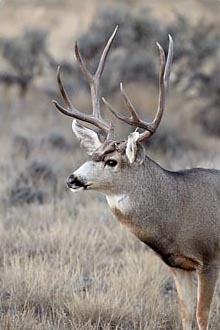
New Mexico, USA
1/125 sec, f5.6, ISO 800
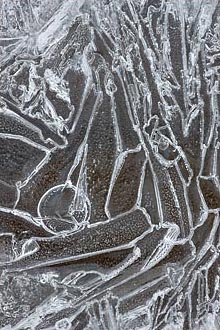
New Mexico, USA
1 sec, f16, ISO 100
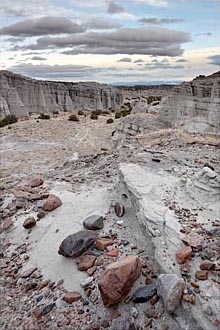
1/20 and 1/6 sec, f11, ISO 100
In the middle of December, we spent nine nights at Abiquiu Lake, an Army Corps of Engineer facility between the town of Abiquiu and Ghost Ranch where Georgia O'Keeffe spent several years painting the red rock country. We got some snow, but it was cloudy most of the time which wasn't very interesting for photography. During one of the breaks in the cloud layer, the cliffs near Ghost Ranch were illuminated by some warm afternoon light, and we headed over to photograph them. Chimney Rock (below left) is a prominent formation there, and the dark clouds behind it made for an interesting image. On another afternoon, we explored Plaza Blanca where Georgia O'Keeffe painted her From the White Place. The white sandstone cliffs by themselves weren't photographically interesting to me, but by including some brown and black rocks in the foreground and some interesting clouds in the background, I was able to make an image that works for me (above right). Lots of birds visited our campsite, so I took the opportunity to photograph them, including a nice Oregon Junco (below right).
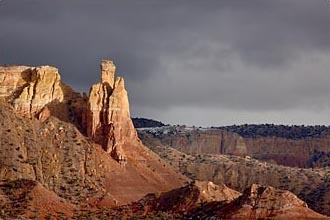
1/125 sec, f11, ISO 100
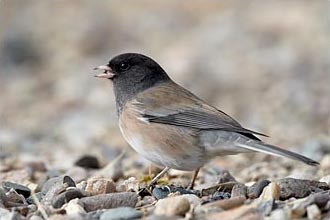
1/500 sec, f8, ISO 400
Travel: Chaco Culture National Historical Park
Towards the end of December, we went to Chaco Culture National Historical Park for two nights. It was the first time either of us had been there, and Jan had wanted to go for quite some time. The park is reached by taking a 16-mile (25 km) dirt road from US-550. The road was in fairly good condition, but it was muddy from the recent rain and snow. We unhooked the Jeep before getting on the dirt road so it wouldn't get covered with mud from the RV. At one point, the rear of the RV tried to catch up to the front, and Jan was quite alarmed to see me going down the road sideways before I got it headed in the right direction again.
There are several pueblos and rock art sites in the park, and we especially enjoyed photographing at Chetro Ketl and Pueblo Bonito. I was drawn to the stone work, and three beam ends (below left) formed a perfect anchor for a composition. The short trail between Chetro Ketl and Pueblo Bonito goes by a cliff covered by petroglyphs (below center). The ruins of Pueblo Bonito are quite extensive and include several kivas — large round rooms used for religious purposes. One of the kivas had an interesting cluster of tumble weeds in it (below right).
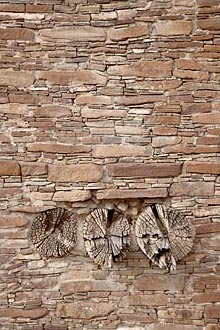
New Mexico, USA
(at 80mm), 1/15 sec, f11, ISO 100
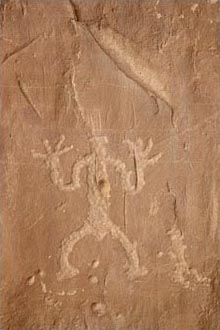
New Mexico, USA
(at 98mm), 1/45 sec, f8, ISO 100
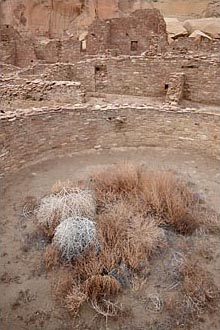
New Mexico, USA
0.3 sec, f11, ISO 100
Travel: Bisti Wilderness
We started our week-long stay at the Bisti Wilderness on Christmas Eve, and received some nice weather presents during our stay. It took me a while to start pronouncing Bisti like "Bist-Eye" as the locals do. We had nice clouds most afternoons and were excited to include them in our compositions. On the way to The Wings one afternoon, I stopped to photograph some mushrooms with the nice clouds (below left). The mushroom is composed of a hard cap rock that's about 4 ft (1.2m) in diameter that's supported by softer sandstone. I used the shift motion of the 24 TS II to look up without creating keystoning. While the clouds were nice overhead, by the time we reached The Wings for sunset, the clouds to the west were too thick and prevented the clouds overhead from lighting up.
On another afternoon, we hiked out to the Egg Factory, an area with lots of large concretions, about 2x4 ft or 60x120cm, on the ground. By the time we got there, the clouds had moved off, so I waited until after the sun had set and then photographed just the eggs and avoided including the not-so-interesting sky (below center). I used Live View for the first time in the field to help me adjust and focus the 24 TS II. The 24 TS II is a manual focus lens, and the viewfinder of my Canon EOS 1Ds Mk III isn't designed for manual focus. It's so much better to be able to use Live View to zoom into critical areas to adjust tilt and focus. I used the tilt motion of the 24 TS II to align the plane of focus along the eggs.
We got some snow towards the end of our stay at Bisti and the clouds broke the following morning so we headed back out to the Egg Factory. We stopped to photograph along the way, and my favorite image is of some scattered boulders (below right). I used the tilt motion of the 24 TS II to align the plane of focus along the boulders. By the time we reached the Egg Factory, the snow had started to melt and the sun was rather high in the sky. On our way back to the RV, clouds moved in and it started snowing again. It was a long walk with it blowing right into our faces!
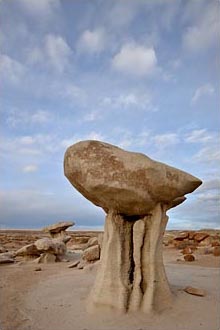
1/45 sec, f11, ISO 100
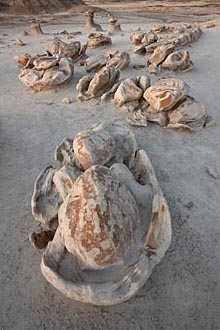
6 sec, f11, ISO 100
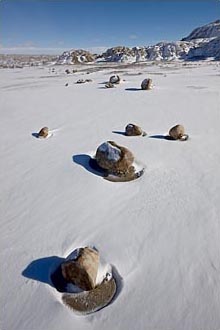
1/350 sec, f11, ISO 100
On another afternoon, we headed back to The Wings because the clouds were looking good again, and we were treated to some fantastic color at sunset (below left). I kept photographing after the color faded and the light became more diffuse, and improved on one of my favorite compositions from our previous stay at Bisti (below right). Next time, I'd like to have the colorful clouds in the right place for that composition to work.
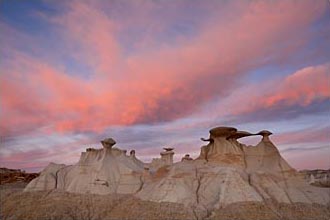
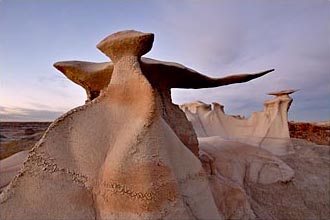
Travel: Rio Grande Zoo, Albuquerque
We went to the Rio Grande Zoo, part of the Albuquerque Biological Park, for a morning on our way south. Their enclosures for gorillas and orangutans are great for photography. It was cold when we arrived in the morning, and most of the animals weren't outside. A peacock that was perched atop a split-rail fence was the most exciting subject we came across early on (below right), and I was able to use my new Canon EF 70-200mm f2.8L IS II USM for the first time in the field. After it warmed up a bit, the animals started coming out, but by then the thin cloud layer had moved out and there were harsh shadows. Fortunately, one of the western mountain gorillas posed nicely in the shade, and I was able to capture my favorite gorilla portrait ever (below left)! The orangutans stayed out in the sun making photography difficult, but I couldn't resist photographing the old female eating a piece of ice (below center).
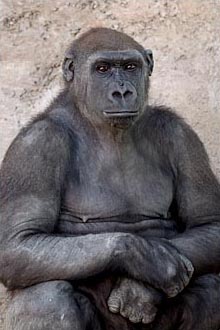
New Mexico, USA (captive)
1/60 sec, f8, ISO 640
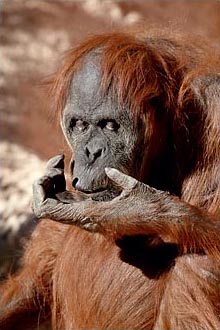
New Mexico, USA (captive)
1/750 sec, f8, ISO 400
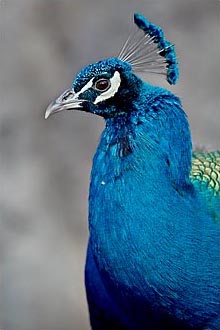
New Mexico, USA (captive)
(at 200mm), 1/250 sec, f5.6, ISO 400
Travel: Bosque del Apache National Wildlife Refuge
In early January, we spent three nights near Bosque del Apache National Wildlife Refuge. Bosque is a mecca for wildlife photographers who gather to photograph the wintering sandhill cranes and snow geese. When the wind is strong, sandhill cranes "parachute" during their final approach to landing, and we were fortunate one evening to have strong winds with a colorful sky (below left). The following morning, conditions were good to photograph the sandhill cranes taking off from the pond where they had spent the night (below right).
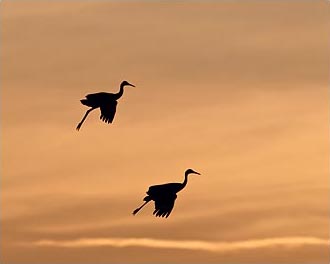
New Mexico, USA
1/1000 sec, f9.5, ISO 400
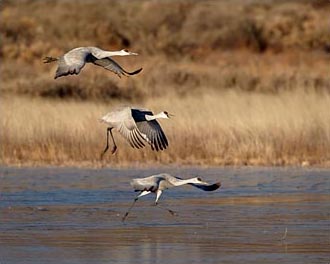
New Mexico, USA
1/1000 sec, f8, ISO 250
Bosque is also good for photographing other species, in particular several kinds of ducks. Northern pintail (ducks) are rather pretty, and I was able to get some nice shots of them swimming in one of the managed ponds in the refuge. Then one day, as we were driving around the refuge, we came upon a coyote ahead of us trotting down the road in the same direction we were traveling. As I slowly closed the gap between us, I saw that the coyote was carrying a duck of some sort in its mouth. As it rounded a turn in the road, I saw that it was a pintail! We kept following the coyote at a respectful distance, and after a while it turned off the road along a small stream. It went maybe 20 yards (20m) away from the road then paused giving us a great opportunity to photograph it (below left). I was surprised that the pintail was still rather lifelike and that it looked rather happy. (There's something about the upturned gray part of the pintail bill that makes them look happy to me.) The pintail was not only lifelike, but it was in fact alive — it was moving! I was amazed that the coyote put down the pintail for a few minutes after the image was taken. Then the coyote picked up the pintail, trotted back to the road and kept going. We continued following it along the road, then watched it head out into some grassland and finally disappear into some brush. What a fantastic encounter!
One morning, we set up to photograph a flock of sandhill cranes in a pond with fog. The fog started to glow at sunrise, and I was drawn to a tree on the far side of the pond. While waiting for the cranes to line up properly, another group of cranes took off and flew through my frame. I fired off a bunch of shots and liked the image below right the best.
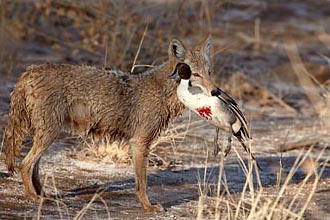
New Mexico, USA
1/350 sec, f9.5, ISO 250
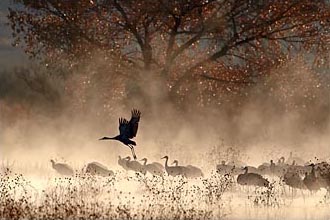
New Mexico, USA
1/1500 sec, f11, ISO 400
We also had a fantastic encounter with a merlin. It was perched in the brush by the road and let us approach in the Jeep and take a few shots. Then it flew down the road about 25 yds (23m), landed in the brush by the road, and let us photograph it again. This happened about five times before it flew away from the road. It was an incredible encounter!
On our first night at Bosque, conditions weren't very good for flight shots, but the thin band of clouds created some nice color in the pond to use for silhouettes (below right).
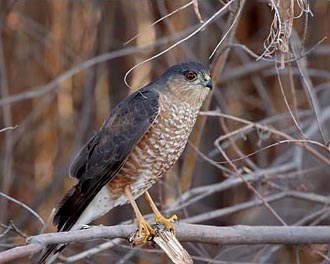
New Mexico, USA
1/90 sec, f8, ISO 640
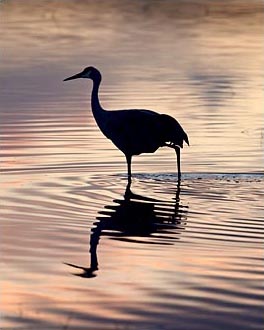
New Mexico, USA
1/180 sec, f8, ISO 400
Next week, I'll be taking some clients to Tanzania for two weeks and then to Rwanda for a week. Then Jan will join me in South Africa for seven weeks on our own. I'll tell you about Tanzania and Rwanda in the next Newsletter.
Take care and happy shooting.
— James
James Hager Photography :: www.jameshagerphoto.com




